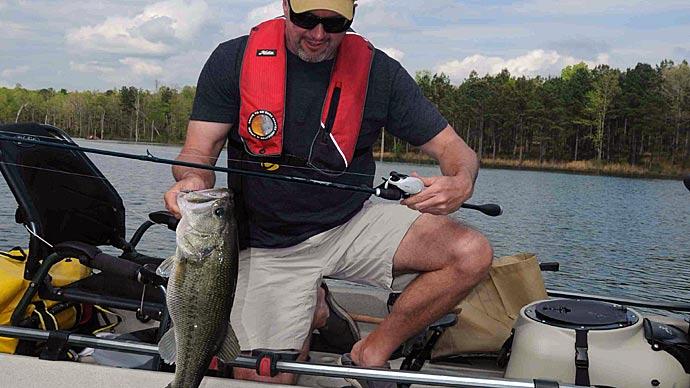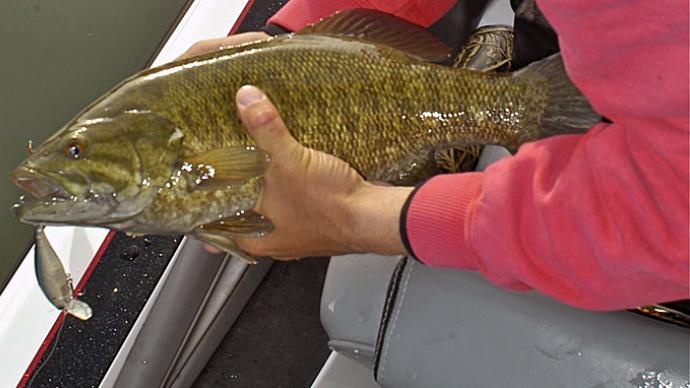
His school artwork never drew much attention, but Tim Hughes' painting skills have made him a Picasso among bass anglers.
Lures custom-painted by the Table Rock Lake guide has been winning so many tournaments in recent years that demand for his artistry has him contemplating quitting the guide business. "I'm sure our baits are over $1 million in tournament winnings," claims the Reeds Spring, Mo., angler whose custom-painted purple-and-chartreuse Rattlin' Rogue has accounted for numerous tournament victories on the clear-water lakes in the Ozarks highlands region.
Equipped with airbrushes and compressors, Hughes chums out colors that attract anglers and fish alike. "The paint schemes are different from anything the fish have seen," he says. "I believe that the fish get accustomed to certain baits, and when they see something different, they are more apt to bite it. If they see a chrome and black-back Rattlin' Rogue all day long and get hooked once or twice, I think they kind of shy away from it." Hughes believes his lures give anglers an edge by showing the fish some hues they have never seen. His custom paint jobs also allow his customers to design their colors for their favorite baits.
The master lure painter recalls doing "okay" in art classes during his school days, but he later refined his skills as a taxidermist.
"I was by no means an artist," he admits. "The taxidermy work did make a difference in my airbrushing. You have to do some pretty fine details on some fish like crappie. It's one of those deals where I would paint one, but I didn't like it, so I would wipe all the paint off and do it over again until I got it right." Through his taxidermy work, Hughes teamed techniques on how to paint natural-looking features on lures, such as how far down the lure's body he should paint its back, where to paint its gills or dots, and what shade of red to use for the mouth or throat.
Believing he had found a way to make a lot of money, Hughes decided to become a taxidermist in 1980. He turned an 8-foot by 8-foot section of his garage into a workshop and started studying a book on the subject. Hughes also learned pointers by hanging around other taxidermists.
His interest in taxidermy waned when he began devoting more time to guiding. "Plus, there wasn't that much money in it for me," says Hughes, who also would spend too much time repainting his work. "I guess I'm too much of a perfectionist. When I'm unhappy with something, I'll wipe it out and redo it."
About eight years ago, Hughes decided to put his airbrush equipment back in service by refurbishing some of his lures. "I had some that were pretty beat up and some I had found in the lake, so I just started repainting them and trying different colors," he says. "The custom painting business just kind of blossomed from there. I had no idea it would become this popular. I just did it as a little sideline thing."
While guiding at Table Rock Lake's Big Cedar Lodge, Hughes attracted attention whenever he came in with a hefty stringer of bass. "Everyone wanted to know what I was catching them on," says Hughes, who told them about his purple-and-chartreuse Rogues.
Then he noticed the same guys would return with their own painted lures. "They would have purple and chartreuse Rogues that looked like they were painted with rollers," Hughes chuckles. "Then they would go out and wouldn't catch fish on them."
Since they couldn't duplicate the quality work produced by the airbrush, Hughes' fellow anglers asked if they could buy his custom-painted lures. "I told them they couldn't afford it, and they would say, 'Yes, we can,'" Hughes recalls.
When he started winning some local tournaments on his custom-painted lures, demand for his work increased. "It just keeps growing every year, and I keep getting more and more of the top touring pros wanting the lures," he says.
His list of clients reads like a Who's Who of professional bass fishing, including Stacey King, Larry Nixon, Randy Blaukat, FLW Tour competitors Guido and Dion Hibdon, Rick Clunn and Brent Chapman, and two-time Red Man All-American qualifier Terry Thomas.
Hughes started painting a couple of hundred lures each year, but the annual workload has risen to about 1,000 baits. His workshop has expanded to a 10-foot by 30-foot room filled with airbrushes, compressors, conveyor belts, and various paints. "That's one thing that has changed over the years," Hughes says of his process. "They have come out with newer, specialized colors, such as holographic and light refracting-type stuff."
The Missouri angler claims he can make various colors for his lures. "I have enough paint to mix and make thousands of colors," he says. "I imagine I have painted 500 or 600 color schemes that people have ordered."

Hughes begins his painting process by removing the lure's hooks and applying a white base coat. Then he applies the other colors and adds features such as fire tiger stripes, gills, dots, and red bleeding marks on the throat and tail. "Just everything that you would see in nature we add to the lure," says Hughes, who even draws the fine hairs on the legs of his crawfish-colored crankbaits.
Hughes completes his work by applying a clear coat and then clipping his baits to a motorized bicycle wheel that constantly turns over, allowing each lure's finish to dry evenly.
Most of his orders are for the purple-and-chartreuse combination. Another popular color combination is the Norman flake -- a purple back with a gray stripe and pearl body mixed with a violet-blue flake. The strangest request he has received was from an angler who needed a duplicate of his worn-out Rogue.
"He wanted another lure painted exactly like that with the hook wear marks and teeth marks in it," Hughes says. "It was probably one of the hardest baits I ever did. I felt like painting one up pretty and then dragging it behind my truck or something."
Adding weight to make buoyant lures suspend is another service Hughes offers anglers. He custom weights stickbaits and crankbaits, including Bagley's Balsa B's. "Those are hard to weight because they are wooden and have a wire harness that goes through them," says Hughes. "If you try to drill into the bait in the wrong spot, you're going to hit the wire harness, and if you don't put the weight in the right spot, the bait will lie sideways on you."
His workshop includes an aquarium that allows Hughes to suspend his lures at a specific water temperature. "If someone says they are fishing 55-degree water, then we will chill the tank down to 55 degrees to test the lure," Hughes says.
The lure painter also dabbles in designing baits. His latest creation is the Double Trouble, a jointed topwater lure that leaves a wake on the surface similar to a jointed jerkbait.
His custom-painted lures have become so popular that he now sells them in bait-and-tackle shops in the St. Louis area, Springfield, Mo.; Kimberling City, Mo.; Paducah, Ky.; and Bentonville, Ark. Hughes' guide business has helped him sell his hand-painted lures to anglers throughout the country.
"Most of the people we guide are from out-of-state, so they see the lures and go home and tell their buddies about them," Hughes says.
While guiding has perpetuated his lure painting business, Hughes believes another avenue could make this venture more successful. "If it can continue to grow each year, I would like to quit guiding, fish tournaments, and do the (lure work) full time," says Hughes, who believes tournaments offer him an excellent opportunity to sell his work. "It would be better for the business for me to be at the tournaments than out guiding. I think I'm good enough to compete with those guys, but I don't know if I'm good enough to win."
If Hughes fishes as well as he paints lures, he'll be making money from his custom work and tournament winnings.
To order any of Hughes' works, write to Tim Hughes Custom Painted Baits, Rt. 5, Box 608, Reeds Spring, Mo., 65737, or call (417) 739-5881.
Content provided by Bass Fishing Magazine, the official publication of FLW Outdoors
Copyright John Neporadny, Jr. All Rights Reserved




